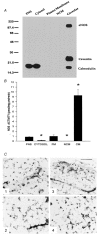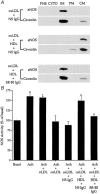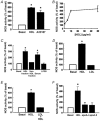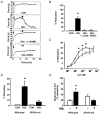Endothelial nitric oxide synthase, caveolae and the development of atherosclerosis
- PMID: 12562964
- PMCID: PMC2342632
- DOI: 10.1113/jphysiol.2002.031534
Endothelial nitric oxide synthase, caveolae and the development of atherosclerosis
Abstract
Early hypercholesterolaemia-induced vascular disease is characterized by an attenuated capacity for endothelial production of the antiatherogenic molecule nitric oxide (NO), which is generated by endothelial NO synthase (eNOS). In recent studies we have determined the impact of lipoproteins on eNOS subcellular localization and action, thereby providing a causal link between cholesterol status and initial abnormalities in endothelial function. We have demonstrated that eNOS is normally targeted to cholesterol-enriched caveolae where it resides in a signalling module. Oxidized low density lipoprotein (LDL; oxLDL) causes displacement of eNOS from caveolae by binding to endothelial cell CD36 receptors and by depleting caveolae cholesterol content, resulting in the disruption of eNOS activation. The adverse effects of oxLDL are fully prevented by high density lipoprotein (HDL) via binding to scavenger receptor BI (SR-BI), which is colocalized with eNOS in endothelial caveolae. This occurs through the maintenance of caveolae cholesterol content by cholesterol ester uptake from HDL. As importantly, HDL binding to SR-BI causes robust stimulation of eNOS activity in endothelial cells, and this process is further demonstrable in isolated endothelial cell caveolae. HDL also enhances endothelium- and NO-dependent relaxation in aortae from wild-type mice, but not in aortae from homozygous null SR-BI knockout mice. Thus, lipoproteins have potent effects on eNOS function in caveolae via actions on both membrane cholesterol homeostasis and the level of activation of the enzyme. These processes may be critically involved in the earliest phases of atherogenesis, which recent studies suggest may occur during fetal life.
Figures







Similar articles
-
High density lipoprotein prevents oxidized low density lipoprotein-induced inhibition of endothelial nitric-oxide synthase localization and activation in caveolae.J Biol Chem. 2000 Apr 14;275(15):11278-83. doi: 10.1074/jbc.275.15.11278. J Biol Chem. 2000. PMID: 10753938
-
High-density lipoprotein binding to scavenger receptor-BI activates endothelial nitric oxide synthase.Nat Med. 2001 Jul;7(7):853-7. doi: 10.1038/89986. Nat Med. 2001. PMID: 11433352
-
A novel ligand-independent apoptotic pathway induced by scavenger receptor class B, type I and suppressed by endothelial nitric-oxide synthase and high density lipoprotein.J Biol Chem. 2005 May 13;280(19):19087-96. doi: 10.1074/jbc.M500944200. Epub 2005 Mar 4. J Biol Chem. 2005. PMID: 15749707
-
Regulation of eNOS in caveolae.Adv Exp Med Biol. 2012;729:51-62. doi: 10.1007/978-1-4614-1222-9_4. Adv Exp Med Biol. 2012. PMID: 22411313 Review.
-
Regulation of endothelial nitric oxide synthase: location, location, location.Annu Rev Physiol. 2002;64:749-74. doi: 10.1146/annurev.physiol.64.081501.155952. Annu Rev Physiol. 2002. PMID: 11826287 Review.
Cited by
-
Scavenger receptor BI prevents nitric oxide-induced cytotoxicity and endotoxin-induced death.Circ Res. 2006 Apr 14;98(7):e60-5. doi: 10.1161/01.RES.0000219310.00308.10. Epub 2006 Mar 30. Circ Res. 2006. PMID: 16574909 Free PMC article.
-
Potential pitfalls in analyzing structural uncoupling of eNOS: aging is not associated with increased enzyme monomerization.Am J Physiol Heart Circ Physiol. 2019 Jan 1;316(1):H80-H88. doi: 10.1152/ajpheart.00506.2018. Epub 2018 Oct 5. Am J Physiol Heart Circ Physiol. 2019. PMID: 30289292 Free PMC article.
-
Phospholipase D2 loss results in increased blood pressure via inhibition of the endothelial nitric oxide synthase pathway.Sci Rep. 2017 Aug 22;7(1):9112. doi: 10.1038/s41598-017-09852-4. Sci Rep. 2017. PMID: 28831159 Free PMC article.
-
Aerobic interval training vs. continuous moderate exercise in the metabolic syndrome of rats artificially selected for low aerobic capacity.Cardiovasc Res. 2009 Mar 1;81(4):723-32. doi: 10.1093/cvr/cvn332. Epub 2008 Dec 1. Cardiovasc Res. 2009. PMID: 19047339 Free PMC article.
-
The Role of Glycocalyx and Caveolae in Vascular Homeostasis and Diseases.Front Physiol. 2021 Jan 13;11:620840. doi: 10.3389/fphys.2020.620840. eCollection 2020. Front Physiol. 2021. PMID: 33519523 Free PMC article. Review.
References
-
- Anderson RG, Kamen BA, Rothberg KG, Lacey SW. Potocytosis: sequestration and transport of small molecules by caveolae. Science. 1992;255:410–411. - PubMed
-
- Blair A, Shaul PW, Yuhanna IS, Conrad PA, Smart EJ. Oxidized low density lipoprotein displaces endothelial nitric-oxide synthase (eNOS) from plasmalemmal caveolae and impairs eNOS activation. J Biol Chem. 1999;274:32512–32519. - PubMed
-
- Cayatte AJ, Palacino JJ, Horten K, Cohen RA. Chronic inhibition of nitric oxide production accelerates neointima formation and impairs endothelial function in hypercholesterolemic rabbits. Arterioscler Thromb. 1994;14:753–759. - PubMed
-
- Chambliss KL, Yuhanna IS, Mineo C, Liu P, German Z, Sherman TS, Mendelsohn ME, Anderson RG, Shaul P. Estrogen receptor alpha and endothelial nitric oxide synthase are organized into a functional signaling module in caveolae. Circ Res. 2000;87:E44–52. - PubMed
Publication types
MeSH terms
Substances
Grants and funding
LinkOut - more resources
Full Text Sources
Research Materials

